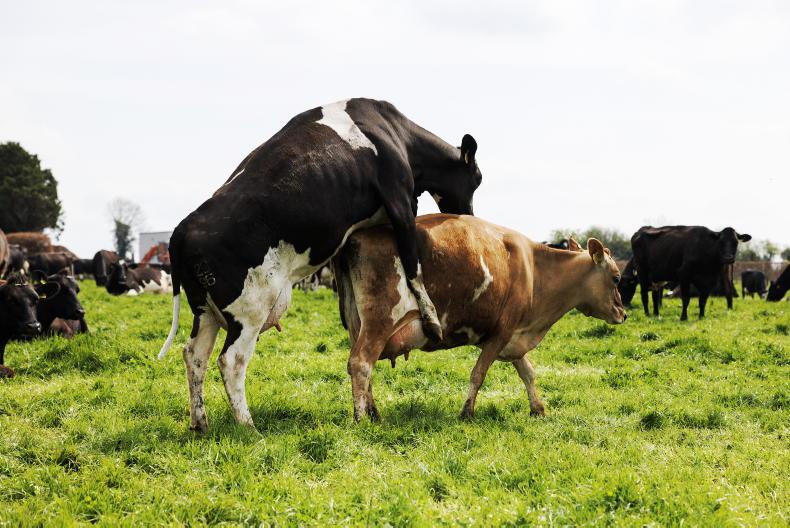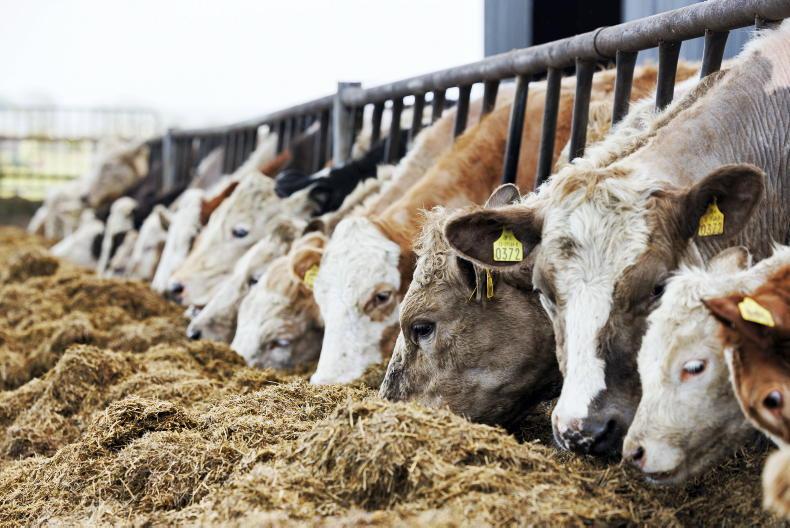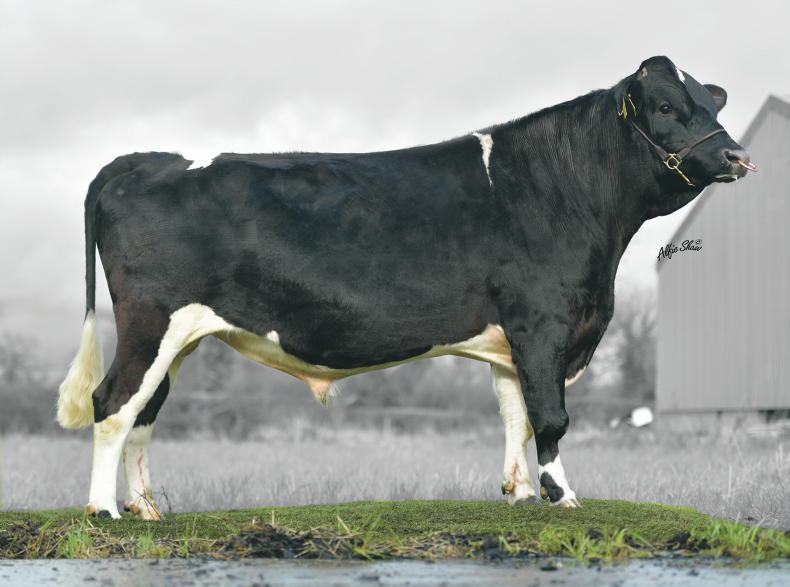It has often been said that there is more work in putting cows in calf, than there is in calving itself, so the next few months are going to be very busy on dairy farms. Like with anything, preparation is key, so take the time now over the next few weeks to be as prepared as possible.
Maiden heifers
Maiden heifers are the highest genetic merit animals on the farm, so the more heifer calves generated from them, the better. The big change in breeding maiden heifers over the last few years is the huge increase in sexed semen and fixed- time AI on heifers. By synchronising the heats, it is possible to have all of the heifers served on the same day. The best policy is to time it, so that they are served a few days ahead of the day that the cows will be starting, to give heifers a head start.
Importantly, heifers must be cycling before a fixed-time AI programme is employed, otherwise the programme won’t work. The best way of ensuring that is by only serving heifers that are at or above target weight and are in good body condition score of 3.25 or greater. The target liveweight at mating is 60% of mature liveweight. So if the mature liveweight is 580kg, then the heifers should be weighing 348kg at mating.
Another key area to get right is the timings for injections and inseminations. This is a non-negotiable, so it’s important to have each treatment clearly labelled. Double and triple check to avoid mix-ups. Make sure there is sufficient help on hand to get through the numbers.
For very large herds, split the heifers into multiple groups and carry out the treatments in rotation. Make sure and consult with the AI technician before putting in the PRID/CIDR about the time of AI that suits them best, so as to ensure it is not clashing with another farmer. The correct protocols are outlined in Figures 1 and 2.
Sexed semen
The popularity of sexed semen is increasing and it looks like 2025 will bring another rise in the percentage of dairy semen used nationally that is sexed. There are mixed reports on the success of sexed semen. I know of farmers who used it in 2023 and were very happy with it, and I know of farmers who used it in 2024 and were somewhat unhappy with conception rates.
Now I’m not saying that there is a universal cause as to why that might be, but in my view it is the year after a good year with sexed semen that issues can occur. These issues could be a general relaxation around the protocols involved.
Look at it this way, in 2023 farmers might have used sexed semen to the letter of the law and had good results. When used appropriately, the conception rates can often be better than conventional semen, because the most fertile cows are used for sexed semen. Complacency can follow and this is dangerous.
A complacent sexed semen protocol could be using sexed semen on cows calved less than 50 days, on cows fifth lactation and above, inseminating cows bulling less than 14 hours and pulling out three or four sexed straws from the flask, rather than one or two at a time.
Therefore, the strong advice for all farmers is to stick to the protocol when it comes to sexed semen. Cows should be in lactation one to four and be calved more than 50 days. On body condition score, only cows with a score of three or more should be put forward for sexed semen. Cows with any health issues since calving should not be given sexed semen either. Handle straws carefully, at no more than two at a time. Thaw at 35-37ºC for 45 seconds and place into a pre-warmed gun.

Follow the protocol for sexed semen use carefully. \ Donal O'Leary
Pre-breeding heat
I’m a big fan of pre-breeding heat detection, as it speeds up the identification of problem cows. Automated heat detection aids make the job easy, but the job shouldn’t be that hard even where tail paint is used.
Best policy is to paint all the cows three weeks out from mating start date (MSD). Seven days later, top up the paint on the cows that still have tail paint on them. In other words, if a cow has paint removed, just ignore her. Repeat this process on the following week. On the third week, which should be just prior to MSD, record the numbers of any cows with paint still present and then re-paint all cows for the start of actual breeding.
The cows that had paint still on need to be investigated. They are either non-cycling, are not calved long enough to cycle or had missed or silent heats. Getting these scanned by a vet at MSD will mean that treatment for whatever problem they may have can be carried out in the first week of breeding, rather than waiting for the third week to pass.
Common issues are cysts, dirty uterine needing a washout, etc. Some will be coming on heat and just need more time. The vet can prescribe treatments for the problem cows.
Beef bulls
Choosing beef bulls to use across the dairy herd might be secondary in terms of importance as using dairy bulls, but important nonetheless. A team of bulls is critical and the advice is to use four or five beef bulls across the herd.
These bulls should be tailored to the cow type, with the overall aim of maximising the beef value of the calf crop while avoiding calving difficulties. For example, using a slightly harder calving beef AI bull on older cows is acceptable, if that bull delivers high beef merit calves. For younger cows, easier calving beef bulls should be used.
Avoid the temptation of just using one bull, even if he ticks all of the boxes. This is to avoid the situation where there is an issue with that batch of straws, his calving difficulty proof changes, or some other issue occurs. A team of bulls overcomes this problem.
In short
The main breeding season will start in the coming weeks on most farms. Getting maiden heifers in-calf to an AI bull will advance genetic gain faster. Use pre-breeding heat detection to identify non-cycling cows and get them seen to.
It has often been said that there is more work in putting cows in calf, than there is in calving itself, so the next few months are going to be very busy on dairy farms. Like with anything, preparation is key, so take the time now over the next few weeks to be as prepared as possible.
Maiden heifers
Maiden heifers are the highest genetic merit animals on the farm, so the more heifer calves generated from them, the better. The big change in breeding maiden heifers over the last few years is the huge increase in sexed semen and fixed- time AI on heifers. By synchronising the heats, it is possible to have all of the heifers served on the same day. The best policy is to time it, so that they are served a few days ahead of the day that the cows will be starting, to give heifers a head start.
Importantly, heifers must be cycling before a fixed-time AI programme is employed, otherwise the programme won’t work. The best way of ensuring that is by only serving heifers that are at or above target weight and are in good body condition score of 3.25 or greater. The target liveweight at mating is 60% of mature liveweight. So if the mature liveweight is 580kg, then the heifers should be weighing 348kg at mating.
Another key area to get right is the timings for injections and inseminations. This is a non-negotiable, so it’s important to have each treatment clearly labelled. Double and triple check to avoid mix-ups. Make sure there is sufficient help on hand to get through the numbers.
For very large herds, split the heifers into multiple groups and carry out the treatments in rotation. Make sure and consult with the AI technician before putting in the PRID/CIDR about the time of AI that suits them best, so as to ensure it is not clashing with another farmer. The correct protocols are outlined in Figures 1 and 2.
Sexed semen
The popularity of sexed semen is increasing and it looks like 2025 will bring another rise in the percentage of dairy semen used nationally that is sexed. There are mixed reports on the success of sexed semen. I know of farmers who used it in 2023 and were very happy with it, and I know of farmers who used it in 2024 and were somewhat unhappy with conception rates.
Now I’m not saying that there is a universal cause as to why that might be, but in my view it is the year after a good year with sexed semen that issues can occur. These issues could be a general relaxation around the protocols involved.
Look at it this way, in 2023 farmers might have used sexed semen to the letter of the law and had good results. When used appropriately, the conception rates can often be better than conventional semen, because the most fertile cows are used for sexed semen. Complacency can follow and this is dangerous.
A complacent sexed semen protocol could be using sexed semen on cows calved less than 50 days, on cows fifth lactation and above, inseminating cows bulling less than 14 hours and pulling out three or four sexed straws from the flask, rather than one or two at a time.
Therefore, the strong advice for all farmers is to stick to the protocol when it comes to sexed semen. Cows should be in lactation one to four and be calved more than 50 days. On body condition score, only cows with a score of three or more should be put forward for sexed semen. Cows with any health issues since calving should not be given sexed semen either. Handle straws carefully, at no more than two at a time. Thaw at 35-37ºC for 45 seconds and place into a pre-warmed gun.

Follow the protocol for sexed semen use carefully. \ Donal O'Leary
Pre-breeding heat
I’m a big fan of pre-breeding heat detection, as it speeds up the identification of problem cows. Automated heat detection aids make the job easy, but the job shouldn’t be that hard even where tail paint is used.
Best policy is to paint all the cows three weeks out from mating start date (MSD). Seven days later, top up the paint on the cows that still have tail paint on them. In other words, if a cow has paint removed, just ignore her. Repeat this process on the following week. On the third week, which should be just prior to MSD, record the numbers of any cows with paint still present and then re-paint all cows for the start of actual breeding.
The cows that had paint still on need to be investigated. They are either non-cycling, are not calved long enough to cycle or had missed or silent heats. Getting these scanned by a vet at MSD will mean that treatment for whatever problem they may have can be carried out in the first week of breeding, rather than waiting for the third week to pass.
Common issues are cysts, dirty uterine needing a washout, etc. Some will be coming on heat and just need more time. The vet can prescribe treatments for the problem cows.
Beef bulls
Choosing beef bulls to use across the dairy herd might be secondary in terms of importance as using dairy bulls, but important nonetheless. A team of bulls is critical and the advice is to use four or five beef bulls across the herd.
These bulls should be tailored to the cow type, with the overall aim of maximising the beef value of the calf crop while avoiding calving difficulties. For example, using a slightly harder calving beef AI bull on older cows is acceptable, if that bull delivers high beef merit calves. For younger cows, easier calving beef bulls should be used.
Avoid the temptation of just using one bull, even if he ticks all of the boxes. This is to avoid the situation where there is an issue with that batch of straws, his calving difficulty proof changes, or some other issue occurs. A team of bulls overcomes this problem.
In short
The main breeding season will start in the coming weeks on most farms. Getting maiden heifers in-calf to an AI bull will advance genetic gain faster. Use pre-breeding heat detection to identify non-cycling cows and get them seen to. 










SHARING OPTIONS